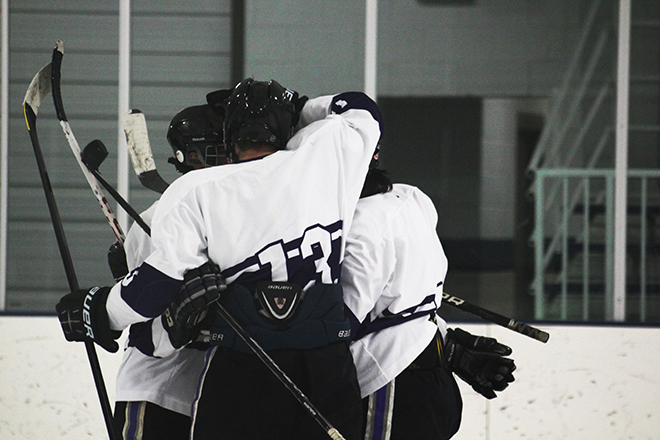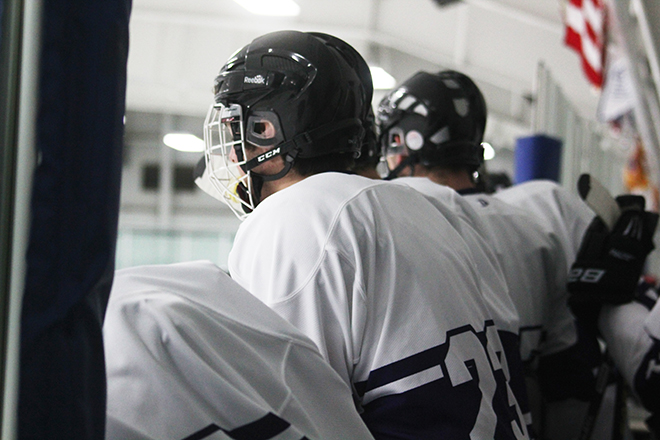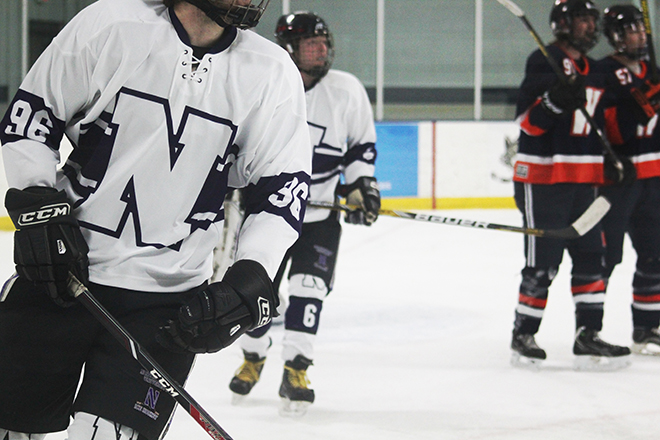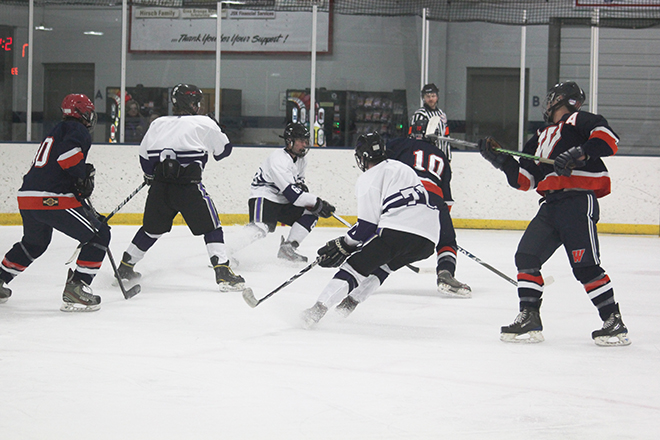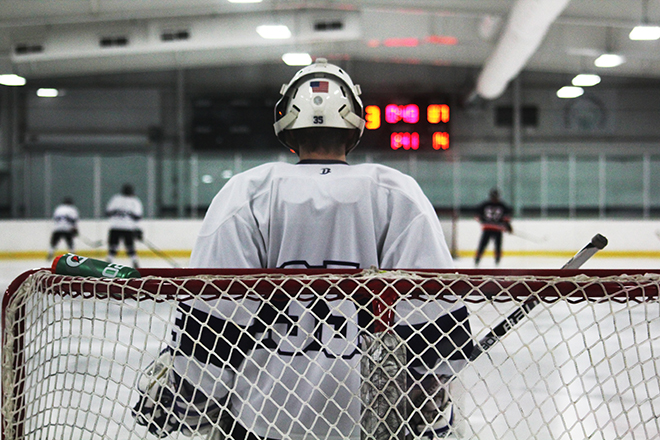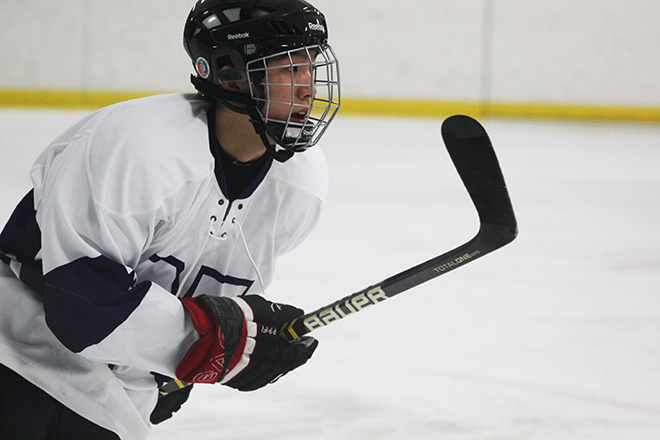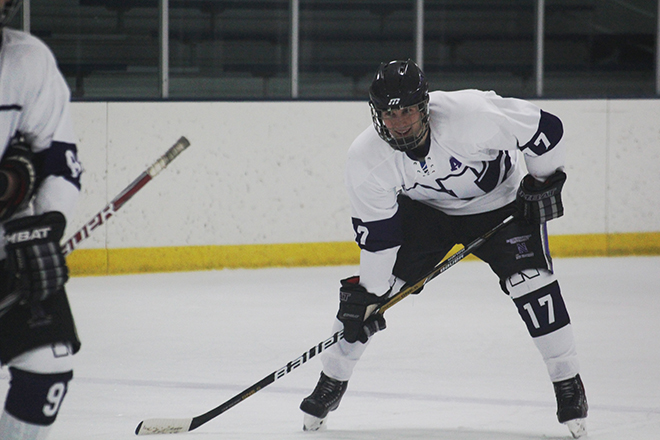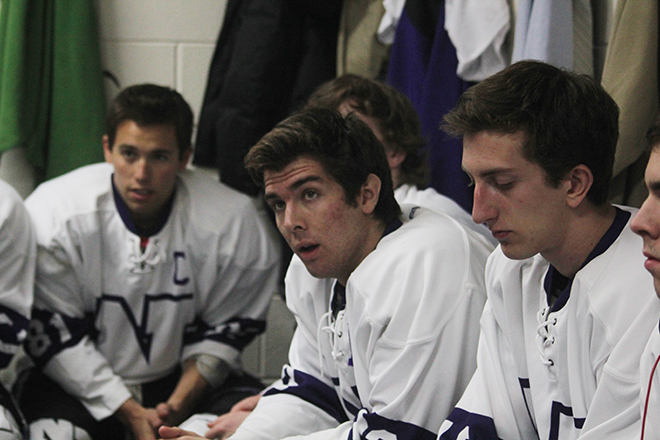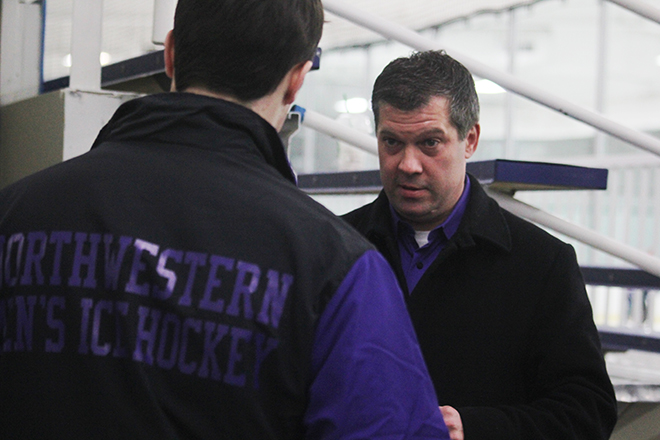On a Saturday night in late January, the Northwestern men's club ice hockey team is up against Wheaton College, a Christian liberal arts school in Wheaton, Ill. The Wildcats win, 11-7. After the sticks and pucks and uniforms are packed away into human-sized purple duffle bags, two Northwestern men's ice hockey players pile into the back of team captain Ricky Gattone’s Jeep.
The thirty-minute drive from the rink back to campus is filled with the contradictory comments of disgruntled young adults who want more. The win was fine, but they regret the way they played. They talk. Reassurance is sincerely given and somberly refuted. Eventually, the dialogue turns from hockey on the ice to hockey on the screen. Losing at the Xbox game NHL 14 is a source of ire, but it’s clear: an easy opponent makes for a boring match.
——-
Last year, the team voted to transfer their home rink to the Centennial Ice Arena in Highland Park. They used to practice and compete at Evanston’s Robert Crown Center, but that venue only allowed for late Friday night games, which killed the college students’ social lives. So, as a trade-off for their fun, the men carpooled every Tuesday and Thursday in six cars to and from the Highland Park rink.
Squirts, hockey players of ten years or under, were finishing up their game when car after car of the older hockey players pulled into the rink. For a while, the Northwestern team bantered, sang and watched the squirts play. Finally, the coaches arrived and the team changed into their uniforms.
When the Ke$ha song "Timber" blared over the loudspeakers, it was as though the lyrics, “It’s going down/ I’m yelling timber/ You better move, you better dance," were a signal. It’s almost a miracle that the players – whose uniforms and pads have bulked each up to twice his previous size – can overcome inertia and sail onto the ice in rapid, graceful arcs.
Northwestern’s hockey team is one of individuals who must actively decide to collaborate every second of the game. Communication is essential, but hockey players speak a different language on the ice. Tapping the stick on the ice means, “I’m open!” while banging it against the wall may be a celebration of a goal, an expression of anger or a demonstration of patriotism at the end of the national anthem. It all makes for a noisy game.
In addition to being a linguist, a hockey player is an innate physicist. You don’t pass the puck to your teammate, you pass it to where your teammate is going. You can launch the puck into the air and knock it down with your glove. To send the puck behind you, hit the puck against the curve of the rink’s wall and watch it glide along the wall to your teammate.
Four men comprise the coaching staff. Players’ families who live in the area sell merchandise at the games. A standard hockey team has 20 players. The Northwestern team is built on 24 men, of which the league allows 21 to be shirted.
The team is broken down into two goalies, six defensemen and twelve forwards. Defensemen are grouped into pairs, and forwards are grouped into lines of four. The lines are fluid – technically, one line takes the ice at a time, but each forward is expected to exit the ice when he is tired (the goal is to stay on the ice for about 45 seconds).
When a forward returns to the bench, a player from the next line will launch onto the rink and begin his minute of playtime.
——-
By the end of the second period, Coach Bryan “Chambo" Chamberlain was not happy. The Wildcats were leading by seven points, and because of their lead, they hadn’t been playing seriously. Good teams, Chamberlain said, would be leading by much more.
Chamberlain, flanked by his coaching staff was stormy-faced as they enter the locker room, which was crammed with equipment, bodies and the smell of warm wet wool.
“Hey! Hey!” some players shouted to quiet their teammates.
“Guys, I don’t know how to say this, “ Chamberlain says without preamble. “Seriously?"
Chamberlain later admitted that he’s intense.
“I want them to learn that what we’re trying to instill here is what the real world is all about,” Chamberlain said. “Hopefully when they graduate and they come back and they say, 'Hey, something I implemented in the real world is something I learned here on the hockey team.’”
When Chamberlain isn’t dissatisfied, the locker room is a place of camaraderie. Chamberlain and the players frequently tell each other, “Let’s play our game,” or, if they’re not doing well, “We’re not playing our game.” After the first period's play, when the team was taking the game more seriously, the players were exchanging instructions amongst themselves.
“Guys, we could be better defensively,” one played had remarked, before launching into a slew of hockey jargon. “They took all their shots outside the tops of circles, which is fine. But let’s get a third guy high. Let’s make it not about the rushes.”
But this time, at the end of the second period, Chamberlain finished his talk by making a demand before the athletes began the third and last period.
“I don’t want hear a word. Not a word. You think about these next twenty minutes.”
——-
In Chamberlain’s early years of coaching, the team should have been a recreational team. They weren’t as competitive. Now, they consistently make playoffs and aim for regionals and nationals. Five years ago, the Wildcats started to actively recruit after a dearth of players made for a rough season. It can be a tough sell - playing for the club hockey team is an investment. New players pay $2400 their first year, and returning players play $2000 each year. No scholarships are available.
It’s worked, however. Today, the Northwestern admissions office makes a list of successful applicants that indicate if a prospective student might be interested in playing for the school. It’s a list that Chamberlain uses every year to build a team for the next four years.
According to Chamberlain, Northwestern hockey is about fun and about competition.
But, he adds, “We’re obviously academics first.”
——-
Weinberg sophomore Petr Palecek did not intend to play hockey when he committed to Northwestern University two summers ago.
Raised in the industrial city of Ostrava, Czech Republic, Palecek lived most of his life playing on ice rinks. Burdened by a severe pollen allergy, he became a hockey player when his parents realized that the sport he played would have to be in what Palecek called a “sterile" environment.
“And what other than a hockey rink?” he laughed. “It’s all ice.”
Hockey could be as popular as soccer in the Czech Republic. At Palecek’s “basic school,” each grade from the third to the ninth was divided into two classes. One is academic, while the other is a “hockey school” that consists of solely hockey athletes. Palecek transferred to the hockey school in the third grade. His days were filled with 10 to 12 hours of hockey practice and not very much lecture. To make up for the lost academic time, Palecek’s dad hired a private tutor to teach his son German and English.
But after a series of injuries, Palecek decided to quit hockey two years before committing to Northwestern University two summers ago. He decided to focus on academia – it came easily to him, even with the time commitment hockey required.
But fate led him back to the ice. His decision to refocus on academics led him to apply to Northwestern, where Chamberlain reached out to him after the admissions office indicated him as a potential hockey player. Palecek was uncertain about joining the team; he waited two months before deciding to play. Finally, he had his mom mail him his equipment –skates, helmet, sticks and pads – an effort that cost about $100 and a month’s time of shipping.
Now, Palecek works with prospective international students at the admissions office. Hockey once more is another time commitment, but it’s manageable – and he plays with a team that he loves.
“You just have to take time from your free time,” he explained simply, “not from your preparing-for-school time.”
At the end of this game against Wheaton, Chamberlain declared Palecek one of the top three best players of the match.
——-
After the game, the two teams formed two lines of purple and red to shake hands. They then form a circle and take a knee on the ice, joining their Christian opponents in prayer out of courtesy.
——-
At one point on the trip home, Gattone starts playing Motown covers of Nickelback and Lady Gaga. “This is a new phase I’m going through,” he explains.
Gattone, a charismatic Weinberg junior from Addison, Ill. (the town, “not Wrigleyville,” he disclaimed), has a non-hockey talent: he can drive through yellow lights without any increase of speed, safely before the light turns red. He claims to be one of the safest drivers on the road – he never texts behind the wheel and his favorite music is accessible at the touch of a touchscreen button. That’s what he tells himself, at least.
“It’s how I sleep at night,” he joked.
A week of hockey is over. The match may not have been up-to-par, but the this season has seen more wins and better playing than last season. The Motown covers play on, and the jeep glides through yellow light after yellow light before finally arriving home an hour before a much-needed weekend begins.

